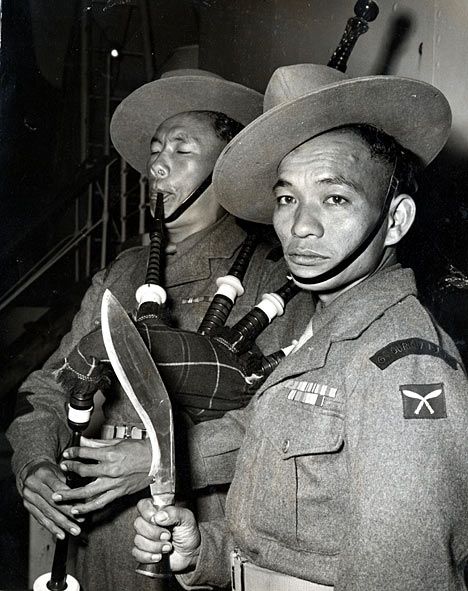Pun, Tul Bahadur
- Date of birth:
- March 23rd, 1923 (Banduk/Myagdit, Nepal)
- Date of death:
- April 20th, 2011 (Banduk/Myagdit, Nepal)
- Service number:
- 10119
- Nationality:
- Nepalese (1768-2008, Kingdom)
Biography
Tul Bahadur Pun was born in Banduk, Nepal on March 23rd, 1923. He entered military service in the Gurkha Brigade and following basic training, he was posted to 3rd Battalion, 6th Gurkha Rifles. The unit was deployed in the Chindits Expedition.
In 1947 he entered military service in the British Army and was posted to 2nd/6th Gurkha Rifles, being deployed in Malaysia and in Hong Kong. During his active military period he rose to the rank of Sergeant-Major. He retired May 1959 and was promoted to the rank of Honorary Major. Pun moved to his birthplace and dedicated his life to farming. He established two primary schools in the vicinity of his hometown. In 2007 he emigrated to Great Britain and settled in Hounslow near London. Later on he relocated to Chiswick.
April 20th, 2011, he passed away in his birthplace Banduk whilst attending the opening of a new school.
Do you have more information about this person? Inform us!
- Period:
- Second World War (1939-1945)
- Rank:
- Rifleman
- Unit:
- 3rd Battalion, 6th Gurkha Rifles, Indian Army (3rd Battalion, 6th Gurkha Rifles, Indian Army)
- Awarded on:
- November 9th, 1944
"In Burma on June 23rd, 1944, a Battalion of the 6th Gurkha Rifles was ordered to attack the Railway Bridge at Mogaung. Immediately, the attack developed the enemy opened concentrated and sustained cross fire at close range from a position known as the Red House and from a strong bunker position two hundred yards to the left of it.
So intense was this cross fire that both the leading platoons of "B" Company, one of which was Rifleman Tulbahadur Pun's, were pinned to the ground and the whole of his Section was wiped out with the exception of himself, the Section Commander and one other man. The Section Commander immediately led the remaining two men in a charge on the Red House but was at once badly wounded. Rifleman Tulbahadur Pun and his remaining companion continued the charge, but the latter too was immediately badly wounded.
Rifleman Tulbahadur Pun then seized the Bren Gun, and firing from the hip as he went, continued the charge on this heavily bunkered position alone, in the face of the most shattering concentration of automatic fire, directed straight at him. With the dawn coming up behind him, he presented a perfect target to the Japanese. He had to move for thirty yards over open ground, ankle deep in mud, through shell holes and over fallen trees.
Despite these overwhelming odds, he reached the Red House and closed with the Japanese occupants. He killed three and put five more to flight and captured two light machine guns and much ammunition. He then gave accurate supporting fire from the bunker to the remainder of his platoon which enabled them to reach their objective.
His outstanding courage and superb gallantry in the face of odds which meant almost certain death were most inspiring to all ranks and were beyond praise."
Private Tulbahadurís Victoria Cross is publicly displayed at The Gurkha Museum, Winchester, Hampshire, Great Britain.
- Period:
- Second World War (1939-1945)
- Period:
- Second World War (1939-1945)
- Period:
- Second World War (1939-1945)
- Period:
- Second World War (1939-1945)
Sources
- Photo 1: Royal Army Photo
- - Supplement to The London Gazette of 7th November 1944, Issue 36785, dated 9th November 1944
- Victoria Cross Reference








